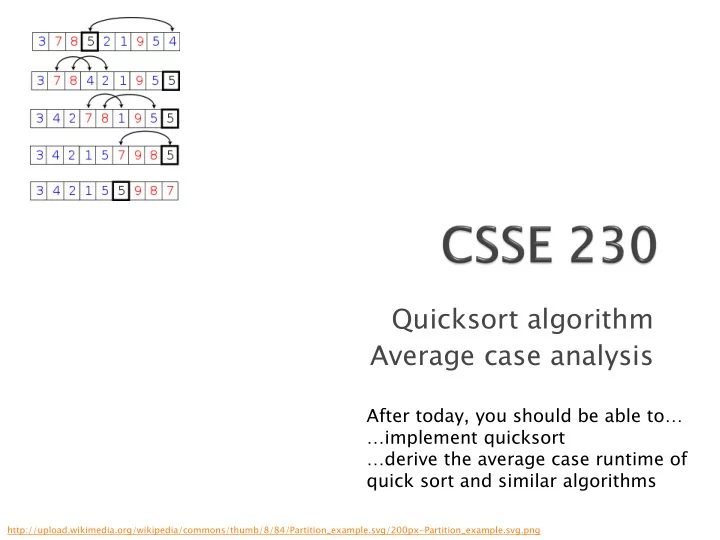

Quicksort algorithm Average case analysis After today, you should be able to… …implement quicksort …derive the average case runtime of quick sort and similar algorithms http://upload.wikimedia.org/wikipedia/commons/thumb/8/84/Partition_example.svg/200px-Partition_example.svg.png
http://www.xkcd.com/1185/ Stacksort connects to StackOverflow , searches for “sort a list”, and downloads and runs code snippets until the list is sorted.
Q1-3 Q1 For any recurrence relation in in th the form rm : 𝑈 𝑂 = 𝑏𝑈 𝑂 + 𝜄 𝑂 𝑙 , 𝑥𝑗𝑢ℎ 𝑏 ≥ 1, 𝑐 > 1 𝑐 The solution is: 𝜄(𝑂 𝑚𝑝 𝑐 𝑏 ) 𝑗𝑔 𝑏 > 𝑐 𝑙 𝜄(𝑂 𝑙 𝑚𝑝𝑂) 𝑗𝑔 𝑏 = 𝑐 𝑙 𝑈 𝑂 = 𝜄(𝑂 𝑙 ) 𝑗𝑔 𝑏 < 𝑐 𝑙 Theorem 7.5 in Weiss
Check out now: ◦ www.sorting-algorithms.com Others: ◦ http://maven.smith.edu/~thiebaut/java/sort/demo.html ◦ http://www.cs.ubc.ca/~harrison/Java/sorting-demo.html
Invented by C.A.R. “Tony” Hoare in 1961* Very widely used Somewhat complex, but fairly easy to understand ◦ Like in basketball, it’s all about planting a good pivot. A quote from Tony Hoare: There are two ways of constructing a software design: One way is to make it so simple that there are obviously no deficiencies, and the other way is to make it so complicated that there are no obvious deficiencies. The first method is far more difficult. Image from http://www.ultimate-youth-basketball-guide.com/pivot-foot.html.
Q4
Q5 Q5 // Assume min and max indices are low and high pivot = a[low] // can do better i = low+1, j = high while (true) { while (a[i] < pivot) i++ while (a[j] > pivot) j-- if (i >= j) break swap(a, i, j) } swap(a, low, j) // moves the pivot to the // correct place return j
Q6-7 Q6 Running time for partiti ition on of N elemen ents ts is (N) Quicksort Running time: ◦ call partition. Get two subarrays of sizes N L and N R (what is the relationship between N L , N R , and N?) ◦ Then Quicksort the smaller parts ◦ T(N) = N + T(N L ) + T(N R ) Quicksort Best case: write and solve the recurrence Quicksort Worst case: write and solve the recurrence average: a little bit trickier ◦ We have to be careful how we measure
Let T(N) be the average # of comparisons of array elements needed to quicksort N elements. What is T(0)? T(1)? Otherwise T(N) is the sum of ◦ time for partition ◦ average time to quicksort left part: T(N L ) ◦ average time to quicksort right part: T(N R ) T(N) = N + T(N L ) + T(N R )
Weiss shows how not to count it: What if half of the time we picked the smallest element as the partitioning element and the other half of the time we picked the largest? Then on the average, N L = N/2 and N R =N/2, ◦ but that doesn’t give a true picture of these worst -case scenarios. ◦ In every case, either N L = N-1 or N R =N-1
Q8 Q8 We always need to make some kind of “distribution” assumptions when we figure out Average case When we execute k = partition(pivot, i, j) , all positions i..j are equally likely places for the pivot to end up Thus N L is equally likely to have each of the values 0, 1, 2, … N-1 N L +N R = N-1; thus N R is also equally likely to have each of the values 0, 1, 2, … N-1 Thus T(N L )= T(N R ) =
Q9-10 Q9 10 T(N) = Multiply both sides by N Rewrite, substituting N-1 for N Subtract the equations and forget the insignificant (in terms of big-oh) -1: ◦ NT(N) = (N+1)T(N-1) + 2N Can we rearrange so that we can telescope?
Q11 Q11-13 13 NT(N) = (N+1)T(N-1) + 2N Divide both sides by N(N+1) Write formulas for T(N), T(N-1),T(N- 2) …T(2). Add the terms and rearrange. Notice the familiar series Multiply both sides by N+1.
Best, worst, average time for Quicksort What causes the worst case? We can guarantee we never hit the worst case ◦ How? ◦ But this makes quicksort slower than merge sort in practice.
Avoid the worst case ◦ Select pivot from the middle ◦ Randomly select pivot ◦ Med edian an of 3 pivot ot sel elec ection tion . (You’ll want this.) ◦ Median of k pivot selection "Switch over" to a simpler sorting method (insertion) when the subarray size gets small Weiss's code does Median of 3 and switchover to insertion sort at 10. ◦ Linked from schedule page What at doe oes th the e of offici cial al Ja Java va Quic icksort ksort do? o? See ee th the e sou ourc rce e code! e!
The he partit titio ion code ode given ven earli lier er has as 2 proble blems: : 1. 1. Can an walk alk off the end d of the e array 2. 2. If the cho hosen sen pivo vot t is dupli plica cated, ted, can an go into to an infin init ite e recu cursio sion // Assume min and max indices are low and high pivot = a[low] // can do better i = low+1, j = high while (true) { while (a[i] < pivot) i++ while (a[j] > pivot) j-- if (i >= j) break swap(a, i, j) } swap(a, low, j) // moves the pivot to the // correct place return j
Recommend
More recommend